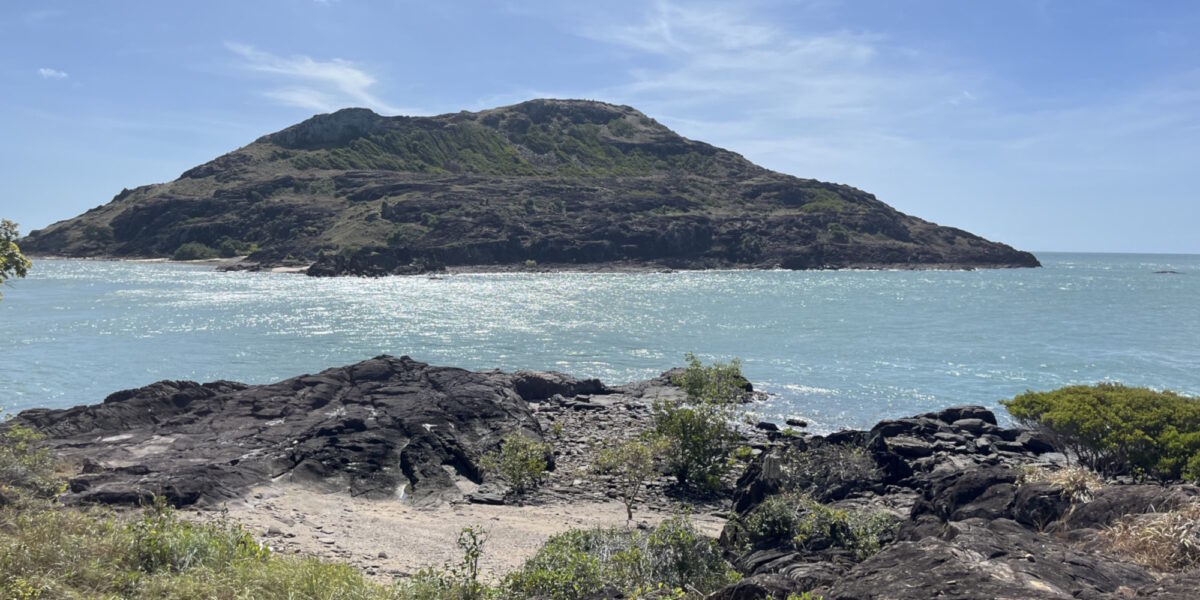It was Thursday, and time for an early escape from Thursday Island. The plan:
- 05:55 taxi transfer to the wharf
- 06:30 board ferry and munch on contents of delicious breakfast boxes as we watch the sun come up over the water
- 07:40 arrive Seisia, Cape York, coach transfer to accommodation in Bamaga
- 08:30 start a day tour to Pajinka
Things almost went to plan, except the breakfast boxes didn’t show up, apparently a miscommunication. Not to worry; the sunrise didn’t disappoint, and our accommodation was able to provide buffet breakfast for us, so we filled up on food before starting the tour.
So where were we, exactly?
The town of Bamaga (population 1186), in Cape York. The area is also known as the NPAR – Northern Peninsula Area Region. It’s the very northern part of Australia’s mainland, somewhat cut off from the rest of the country thanks to a lack of sealed roads and a river crossing to get in.
We found our guides, Michael and Uncle Tommy, and their 4WD minibus, and we headed out.
Our first stop was a WW2 site at the local airport: the crash of a Bristol Beaufort bomber in October 1945 (about a month after the war had finished) amazingly resulted in no injuries.
Less fortunate were the occupants of a DC3 crash 5 months earlier – nobody survived.
Crash sites like these are sobering. As I mentioned previously, WW2 brought huge impacts to this part of the world – even though it was not the centre of fighting.
We stopped briefly at a servo, then headed north.
Our next stop for a leg stretch was Punsand Bay, a camping ground. Plenty of people seemed to be camping, but you can drop in and buy a drink, souvenirs, even a pizza, and use the toilet.
Just note that shirts are required after 5pm in the restaurant.
And it’s right on the beach, which once again had me disbelieving that it was the middle of winter.
Onward for a bit, then we made a stop in the forest for our guides to give us an official welcome and some background to this part of the world, their part in it, the way their people interact with the land, their totems and spiritual beliefs – a fascinating mix of traditional and Christian.
It felt way more special than just driving straight in under our own steam or with a guide imported from elsewhere.
We continued on to Somerset. No, not the Somerset where I have relatives.
Somerset, Queensland was a town and port established in 1864, largely run by the Jardine family – who did not have a happy relationship with the local indigenous people, whose population fell dramatically within a decade or two, due to factors including introduced disease and frontier violence.
By 1876 the town’s role as a port was redundant because it had been found that Thursday Island was a better option, and the settlement was eventually abandoned.
We stopped at Somerset Bay, and after a short walk, had lunch and chatted about the local history, while we waited for the tide at the tip to go out.
Then the drive to Pajinka, where the 4WD showed its worth. As you can see in this video, some sections had substantial amounts of water (it’s a rainforest after all) – though we didn’t see any crocs!
By the time we reached Pajinka, as anticipated, the tide was out.
We walked along the flats, scrambled over some rocks, and made our way to the Tip, accompanied by another group (in matching shirts).
It was pretty cool to be there.
Some of us returned via the flats; another group of us took the overland way back, involving more climbing, which provided some awesome views.
Our guides – who in this case are also traditional custodians of this area – noted they’re not very pleased that some people like to take rocks and pile them up. It may have unintended consequences for the ecosystem. Everything is connected.
So they encouraged us to help deconstruct the rock piles as we walked. Happy to help.
Unfortunately this isn’t the worst behaviour from tourists in recent years – graffiti and other vandalism, doughnuts and burnouts on the beach, and more.
People can be such pigs. How about respecting the place, and leaving it as you found it?
A marker told us it was 770 km to Cairns, 2170 km to Brisbane, 2720 km to Sydney, and 3020 km to back home in Melbourne.
On the way back we had a quick stop at a site we passed on the way up: the Croc Tent – a kind of information centre and shop (with plenty of crocodile-themed goods) on the road to the tip.
They had plenty more of those coloured shirts popular in this part of the world.
From there we headed back to our accommodation in Bamaga.
To cap it off, there was an amazing dinner in the restaurant, which was a real treat. A great finish to a great day – and more scheduled for tomorrow.











2 replies on “Pajinka”
Daniel, Do you know why Australia is often referred to as a continent? There are 7 continents in the world, namely Asia, Europe, Africa, North America, South America, Oceania, Antarctica. There is no country in Antarctica. All sovereign countries must belong to one of the other six continents. Australia, together with Papua New Guinea and New Zealand, belongs to Oceania.
You wouldn’t really expect me to know this would you?! :-)
From a quick Google… The division of continents is a bit arbitrary, and in some cases seems to reflect cultural differences rather than geological – eg Europe/Asia.
In the English speaking world they call Australia a continent and Oceania a geographical region. But the terminology is different in the non-English speaking world.
https://education.nationalgeographic.org/resource/Continent/
https://en.wikipedia.org/wiki/Continent
https://en.wikipedia.org/wiki/Oceania